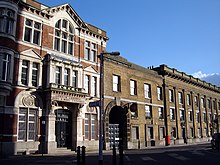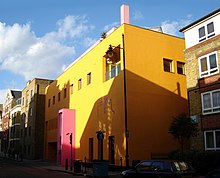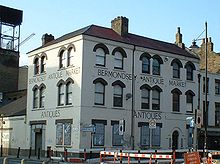Bermondsey (London)
| Bermondsey | ||
|---|---|---|
| St Mary Magdalen Church | ||
| Coordinates | 51 ° 30 ′ N , 0 ° 5 ′ W | |
| OS National Grid | TQ335795 | |
|
|
||
| Residents | 55,281 (as of: 2001) | |
| administration | ||
| Post town | LONDON | |
| ZIP code section | SE1 SE16 |
|
| prefix | 020 | |
| Part of the country | England | |
| region | London | |
| London Borough | London Borough of Southwark | |
| British Parliament | Bermondsey and Old Southwark | |
Bermondsey is a district of London on the south bank of the Thames and belongs to the London Borough of Southwark . To the west lies Southwark , in the east Rotherhithe and south close Walworth and Peckham on.
history
Toponymy
Bermondsey is derived from the Old English name Beornmund and the also Old English name eg for island. Beornmund was probably the name of a person who had a connection with this place and eg, which later changed to ey, referred to an island as well as simply a piece of land on a river. Therefore Bermondsey must not have been an island in Anglo-Saxon times, but probably a higher, dry piece of land in the middle of a river marsh. Bermondsey is actually mentioned in writing for the first time in the Domesday Book of 1086, but there is an earlier source, of which only one copy made in the 12th century in Peterborough Abbey exists, which credibly describes earlier events: the letter of Pope Constantine (708th centuries) -715), in which he confers privileges on a Vermundsei monastery , which was then headed by the Abbot of Medeshamstede (old name of Peterborough).
Anglo-Saxon and Norman periods
Bermondsey appears in the Domesday Book as Bermundesy or Bermundeseye . Most of it was then in the hands of William the Conqueror , but a small part also belonged to Robert de Conteville , the king's half-brother and younger brother of Odo of Bayeux , then Earl of Kent. Her “Domesday” holdings were listed as 13 hides , “a new, beautiful church”, five plows , 20 acres (81,000 m²) of meadow and forest for five pigs. They made a total of £ 15. They also included interests in London on which 13 burgesses (44 pence, £ 0.18) were paid.
The church mentioned in the Domesday Book was believed to be the growing Bermondsey Abbey , founded in 1082 as a priory of Cluny Abbey and dedicated to Saint Salvator (English: St Savior). Monks from the abbey began developing the area, cultivating the land and fortifying the river banks. They built a harbor basin in the Neckinger estuary , which they named St Savior's Dock after their abbey . But Bermondsey then was little more than an elevated embankment (now Bermondsey Street) that led from the Thames bank on what is now Tooley Street to the abbey's gate.
Land here also belonged to the Temple Order and they gave their name to one of the most famous streets in London, the Shad Thames (corruption of "St-John-at-Thames"). Other ecclesiastical properties were near Tooley (corruption of "St Olaf") Street in the Archbishop of Canterbury's Southwark mansion . B. the Priors of Lewes and St. Augustine at Canterbury, and the Abbot of Battle , had their houses.
14th Century
King Edward III built a mansion near the Thames in Bermondsey in 1353. The excavations of the foundations can be seen in the street Bermondsey Wall East near the pubs Famous Angel see
17th century
As it developed over the centuries, Bermondsey has undergone great changes. After the Great Fire of London , the wealthy settled there and the area became a kind of garden suburb, particularly along Grange Road, when Bermondsey Street was further urbanized, and along Jamaica Road and Lower Road. In the 17th century a convertible garden was laid out there, which is still remembered today by the street name Cherry Garden Pier . Samuel Pepys visited Jamaica House and Cherry Gardens in 1664 and noted in his diary that he left them "singing merrily".
One of the few buildings from this period that survived to this day is St Mary Magdalen's Church on Bermondsey Street, completed in 1690 (although a church was mentioned there as early as the 13th century). This church was not touched when the district was redesigned in the 19th century, nor was it damaged by the German air raids on London in World War II . Not only in Bermondsey is a church from this period a specialty, in the entire city center of London such old buildings are rare.
18th century
In the 18th century, the discovery of a spring led to the development of Bermondsey as a spa. The Spa Road between Grange Road and Jamaica Road is still a reminder today. A new church was built for the growing population and was consecrated as St John Horleysdown .
19th century
On the banks of the Thames in Bermondsey, the painter William Turner created his famous painting The Fighting Temeraire Tugged to her Last Berth to be Broken Up (1839), in which he painted the old warship that was towed to Rotherhithe for dismantling.
By the mid-19th century, parts of Bermondsey, especially along the river, had become notorious slums, home to immigrant workers from the new industrial plants and port facilities. The area east of St Savior's Dock called Jacob's Island was one of the worst in London. Charles Dickens immortalized it in his novel Oliver Twist , where the main villain Bill Sikes met a filthy death in the mud of the Folly Ditch - the result of an attack by Spring Heeled Jack that is believed to have ravaged Jacob's Island in 1845. Dickens gives a vivid description of the situation at the time:
"... quirky wooden galleries, usually attached to the back of half a dozen houses, with holes to look through on the mud underneath; windows, broken and mended, with wooden sticks sticking out from which to dry the linen can that is never there; rooms so small, so dirty, so cramped that the air seems too spoiled even for the dirt and filth in it; wooden chambers that stretch outward over the mud and threaten to fall into it - as has happened a number of times; dirt-smeared walls and decaying foundations, every repulsive facial feature of poverty, every disgusting sign of filth, rot and rubbish: all this adorns the shores of Jacob's Island. "
Bermondsey Town Hall was built on Spa Road in 1881. In the 19th and early 20th centuries, the district was significantly redesigned with the expansion of river traffic and the introduction of the railroad. London's first passenger station was built in 1836 on London Bridge by the London to Greenwich Railways (later: South Eastern Railways). The first section of this railway was put into service between Spa Road Station and Deptford High Street. The first station was closed in 1915.
The industrial boom of the 19th century led to an expansion of the previously installed manufacturing capacity in Bermondsey. As in the East End , many industries were settled here that were thought to be too loud and dirty for the cramped inner city of London; one of them was the treatment and trade in leather and animal hides . Many buildings from that period have survived around Leathermarket Street to this day, including a. the huge leather, hide and wool exchange (now a residential building with small shops). The Hepburn and Gale’s tannery (closed in 2007) on Long Lane was also an important survivor of leather processing.
20th century
East of Tower Bridge , the 3½ miles (5.6 km) of Bermondsey's shores were built with warehouses and ship berths, the most famous of which is Butler's Wharf . They survived the devastating bombardment of World War II and then became obsolete in the 1960s with the collapse of river trade. After lying idle for a few years, the London Docklands Development Corporation (LDDC) took them on in the 1980s . They have been converted into a mix of residential and business districts and have become the finest and most sought after properties in London. In 1997, US President Bill Clinton and British Prime Minister Tony Blair visited the area to dine at the Pont de la Tour restaurant in Butler's Wharf.
Bermondsey was home to London's first railway line, which ran from Spa Road and was part of the connection from London Bridge to Greenwich, and Brunel's Rotherhithe Tunnel railway junction became part of the East London Railway with the initial connections from Liverpool Street station across Whitechapel to New Cross and New Cross Gate. At the end of the 20th century, the railway lines in London were reorganized and the routes in Bermondsey were restricted. In 2000 this was corrected with the opening of the Bermondsey underground station on the extension of the Jubilee Line and the East London Line of the new London Overground , which again creates connections with the City of London and North London.
Territorial reforms
The first Bermondsey is the site of the Anglo-Saxon monastery and from later sources we know that the area around the Norman abbey Bermondsey and the manor house was so named, which in turn was part of the medieval parish. In the parliamentary roles it is described as "in Southwark". The later parish of Bermondsey did not include Rotherhithe and St Olave's, which was established in the Metropolis Management Act of 1855. The parishes of St Olave and St John Horleysdown in Southwark (the latter emerged from the former), as well as St Thomas, formed a parish community called St Olave from that time on. This was agreed in the county of London in 1889. In 1899, the single district St Olave and St Thomas was formed and merged the following year with Rotherhithe and part of Deptford together with Bermondsey to form the Metropolitan Borough of Bermondsey . This body went on in 1964 with the reorganization of Greater London in the London Borough of Southwark .
Constituencies
The Southwark Borough Council has divided the suburb into a number of city electoral wards. The constituencies of Grange, Riverside and South Bermondsey make up the Bermondsey constituency.
Bermondsey's representation in parliament changed with its population. It had been part of the Southwark constituency since the late 13th century . From 1885 to 1918, Bermondsey had its own constituency , which included part of the older Southwark constituency. In 1918, the associated parliamentary seat was divided between two new local authorities: Rotherhithe and Bermondsey West , which remained current until the 1950 parliamentary election. Then Bermondsey got his own parliamentary seat back.
In 1983 the famous by-election took place in Bermondsey, in which Labor MP Peter Tatchell lost 44% of the vote and his seat in parliament, believed to be safe, to the Liberal Simon Hughes . Hughes has since represented the constituency, although the boundaries and naming of the constituency have changed. For the 1983 general election, which took place a few months after the by-election, a new constituency Southwark and Bermondsey was created, which was renamed North Southwark and Bermondsey in 1997 , since 2010 is Bermondsey and Old Southwark .
Web links
Individual evidence
- ↑ Entry at bealondoner.com
- ↑ E. Eckwall: The Concise Oxford Dictionary of English Place-Names . 4th edition. Oxford University Press. Oxford (1960). P. 39 and 161
- ↑ FM Stenton: Medeshamstede an its Colonies in: DM Stenton (editor): Preparatory to Anglo-Saxon England Being the Collected Papers of Frank Merry Stanton . Oxford University Press. Oxford (1970)
- ↑ J. Blair: Frithuwold's Kingdom on the Origins of Surrey in S. Bassett (Editor): The Origins of Anglo-Saxon Kingdoms . Leicester University Press. Leicester (1989)
- ^ A. Williams & GH Martin (editors): Domesday Book, A Complete Translation . Penguin (2002). P. 72 and 80
- ↑ Entry in English Heritage ( Memento from August 2, 2011 in the Internet Archive )
- ^ Welcome to your Bermondsey Community Council . Southwark London Borough Council ( Memento of the original from August 10, 2009 in the Internet Archive ) Info: The archive link was automatically inserted and has not yet been checked. Please check the original and archive link according to the instructions and then remove this notice.







